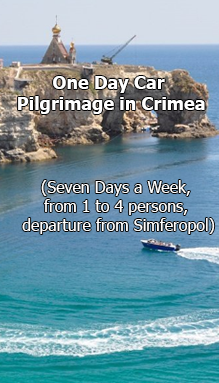Town Residence of the Inkerman Monastery with the Temple of the Twelve Apostles in Balaklava
| Status: | active town residence of the Monastery | |
| The construction has no analogues either in Crimea, or in Asia Minor, or in the Balkans — one-dome, four-pedestal cross-building, with a classical portico at the west facade. About the time of the Church building some researchers judged by the stone built in the wall. On it there is an inscription about the Temple erection in 1357. But it is possible that the stone was used for the second time in a later building. Abolished by the Soviet power, the church was active in the years of the Great Patriotic War, then it was closed for the second time. In 1988–1990 it was restored and revived. From 1993 it was subordinate to the Inkerman Monastery. In 1995 it became the town residence of St. George Monastery. Now it is again subordinate to the Inkerman Monastery. | ||
| Temples: | The Temple of the Twelve Apostles | |
| Location: | Balaklava | |
The history of the Temple of the Twelve Apostles
In 1864 The Bishop of Simferopol and Taurida Hermogenes made a brief historical background about the temple, in which it is written: “Still in 1375 in Balaklava the Church in the name of the Twelve Apostles was built. The real stone church was built in 1794 in the name of St. Nicholas the Wonderworker.”
In 1783 after the annexation of Crimea to Russia, Balaklava was the settlement of the Greek Battalion, having joined the Russian Army. Besides it, during the Russian period the Russians’ affluence and settlement to Balaklava increased, what resulted in the formation of believers’ new community in town. The Church was subordinate to the chief priest of the army and fleet. In it they kept the banners and other relics of the Balaklava Greek Battalion. When in 1859 the Greek Battalion was disbanded, the Temple was subordinate to the diocesan department.
The Temple is a unique monument of the architecture of XVIII c., according to many specialists’ opinion such an architectural type is not found in the structures of Crimea or the neighboring regions and represents in itself a wonderful model of the Russian classical style on the territory of Crimea. The building has symmetrical axial plan and belongs to the number of one-dome churches. The structure is a cross-building, elongate endwise east-west. The Temple represents in itself four-pedestal cross-building from rubble limestone. The west entrance has a portico, consisting of four columns of the Doric order and a three-cornered fronton, cut out of white Inkerman limestone. The Temple is small by volume, but, nevertheless, it is majestic. There are no wall paintings inside, but in previous centuries they may have beautified its walls. The supporting skyward columns, also of the Doric order, produce an impression of greatness.
In 1917 the Temple was abolished. The church was considerably damaged during the earthquake of 1927. During the Great Patriotic War of 1941–1945 the Temple was active, then it was closed for the second time. In its premises at first there was the Pioneer House, and then a club and OSOAVIAHIM Society. In 1990 the Temple building which was being prepared for demolishing was given to the Orthodox Church. Kiev architect Yu. Lositskiy worked out the project of its restoration. With God’s help its revival was started. By tireless work of Archimandrite Augustine (at that time still Protoiereus Alexander) and parishioners the Temple was being restored. While there was the restoration of the Temple, the services were led in a small premise in the yard, admitting about 30 people.
The first service was led on July 13th, 1990 still in the half ruined temple. After a long break under the vaults of the Temple on this day the words of prayer began to sound. And on July 13th, 1991 there was consecrated the Holy throne of the Temple of the St. Twelve Apostles. Now the Church is the town residence of the Inkerman St. Clement Monastery.












